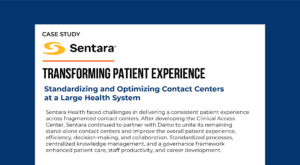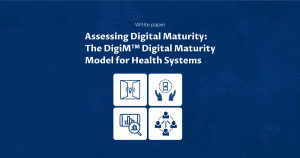Digital health innovation: Addressing the two-canoe problem
Enterprises value demographic and lifestyle data on consumers more than any other form of data. Consumer data use in healthcare enterprises must overcome a few challenges first.
The continuing hold of fee-for-service in payment models has implications for the adoption of technology-led innovation in health systems. In the inevitable shift towards value-based care, health systems relying on fee-for-service face shrinking operating margins that impose severe limits on the enterprise’s ability to fund innovation programs. Many health systems are therefore stuck in a “two-canoe” syndrome – clinging to the safety of assured revenue streams through fee-for-service while trying to transition to value-based care without putting the business at risk.
Health systems across the nation are competing today on quality and price. The quality of care and the price at which it is delivered are under scrutiny. Health systems have, by and large, exhausted the toolbox of traditional methods of lowering cost and improving quality. The patient experience of care and the patient’s ability to access care at a time and modality of their choosing, not to mention transparency in the costs of care, are driving competition and a transformation of the healthcare business. Technology-led innovation is no longer an option, but a necessity for health systems trying to break out of the downward spiral.
In my podcast, The Big Unlock, I have had the opportunity to feature several senior executives responsible for innovation programs in their health systems. My conversations have provided insights into how leading health systems are balancing their immediate priorities with investments for a digital future in a value-based care era.
How Chief Innovation Officers in health systems are harnessing digital health innovation
Karen Murphy, EVP and Chief Innovation Officer at Geisinger Health System, defines digital health innovation as a fundamentally different approach to solving a problem that has quantifiable outcomes. Geisinger’s Fresh Food Farmacy initiative uses population health analytics to identify type 2 diabetics with multiple chronic conditions and food insecurity for targeted interventions that deliver positive outcomes beyond what can be achieved through medication alone.
Many health systems have long had internal functions to enable medical innovations. Digital health innovation is relatively new, and leading health systems are developing their innovation models to encourage internal innovation and also tap into external innovation. An example is a three-step approach adopted by Aaron Martin, Chief Digital Officer at Providence Health. Whenever there is a need for a new capability, the innovation group at Providence looks at internal innovation for available solutions that can be leveraged, after which they proceed to scan the digital health marketplace for ready-to-deploy solutions. If neither approach yields results, they look at building the solution internally. Depending on its success, the solution is commercialized as a spin-off, as was the case with Xealth, a digital health platform developed in-house at Providence Health that has gone on to become an independent company.
Other healthcare enterprises are adopting digital health innovation models that monetize data and clinical expertise to help promising digital health companies validate their solutions and potentially deploying them within the enterprise. (read my blog The new innovation model: monetizing healthcare data).
The innovation ecosystem’s challenge: scale and sustainable revenues
Despite the billions in venture capital, the path to success for even the most promising and innovative startups is marked by significant roadblocks. “Death by pilot” is probably the most dreaded roadblock for digital health startups today. The effort, costs, and risks of bringing a viable product into the market are so high that many startups burn through available capital and go out of business while waiting for health systems to accelerate the adoption of their solutions.
Lately, health systems have acknowledged that they need to do more to enable startups to be successful by developing clear pathways and milestones for innovative solutions to scale to enterprise-wide adoption. Sylvia Romm, Chief Innovation Officer at Atlantic Health Systems, thinks it’s often about words used to describe relationships. She has decided to “retire” the terms “pilot” and “vendor,” believing that the use of these terms creates barriers that prevent a back and forth relationship where the innovator and the health system are learning from one another.
Chief Innovation Officers in health systems are aligning themselves to the strategic priorities of the enterprise and focusing their efforts on identifying and integrating innovative solutions to help achieve enterprise goals. Often, their roles overlap with the positions of Chief Information Officers and Chief Digital Officers. My firm’s research indicates that the innovation function in healthcare is often combined with other roles, such as Chief Digital Officer or Chief Technology Officer. Regardless of where the innovation function sits, there is a clearly understood need for active collaboration between individuals with responsibilities for the IT, digital, and innovation functions. At some point, some of these roles may merge or even go away (remember Chief Data Officer?).
The challenge for health systems, as well as the digital health innovators that serve them, remains one of alignment in financial interest. Health systems are pursuing innovation today as stand-alone projects, mostly around patient engagement and telehealth. In the absence of an enterprise digital transformation strategy, many innovation initiatives remain sub-optimal in their impact.
Regardless of how organization and innovation models play out, health systems have to eventually step off one of the canoes and commit to a single way forward. Clearly, that path points in the direction of value-based care as the payment model of the future. Health systems that are already in fully capitated environments have to find ways to innovate while “keeping the lights on.” At Johns Hopkins Medicine, a health system that is essentially in a capitated model of payment due to the tight controls on reimbursements by the state of Maryland, CTO Dwight Raum leverages innovation opportunities to drive operating efficiencies and uses the incremental savings to fund further innovation. It’s a model that might well serve health systems which still have a runway left with fee-for-service models today.
Originally published on CIO.com














